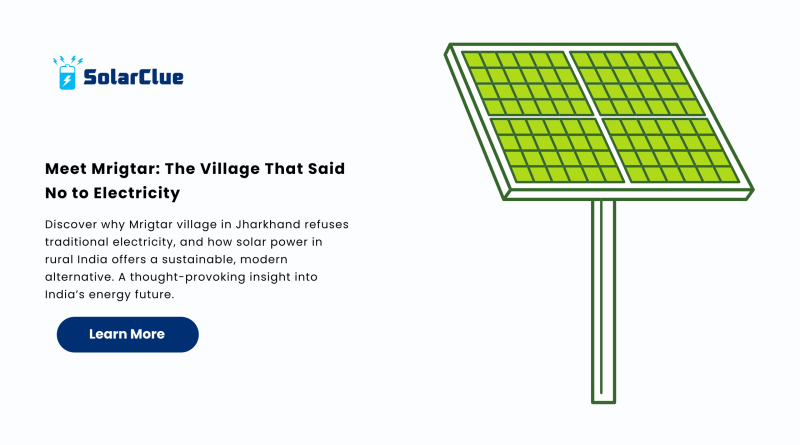Meet Mrigtar: The Village That Said No to Electricity
In a time when much of India is embracing modernization and energy reforms, a small village named Mrigtar, located 55 kilometers from Jamshedpur in Jharkhand, has made headlines for choosing a different path — one away from conventional electricity. Even after the government extended connections to the area, none of the nearly 150 villagers opted to apply.
This unexpected decision sparked national interest. But beneath the headlines lies a larger discussion around energy needs, cultural alignment, and the role of renewable energy in rural India.
Table of Contents
Why Mrigtar Rejected Grid Electricity
While outsiders may view it as backward or puzzling, Mrigtar’s decision is rooted in logic shaped by lifestyle and circumstance:
-
Early-to-rise, early-to-sleep routine: Most villagers are asleep by 7 p.m. and awake before sunrise for farm duties.
-
Minimal night-time electricity demand: Their dependence on daylight and kerosene lanterns meets their current lifestyle.
-
Fear of disruptions: The village is within a region troubled by Maoist activity, and locals fear that external developments could disrupt their fragile peace.
Their decision isn’t about resistance to development; it’s about the relevance and usability of modern utilities in their lives.
Is This a Setback for Rural Electrification?
At first glance, it might seem like Mrigtar’s rejection is a setback for India’s rural electrification efforts. However, it’s more of a wake-up call. This case highlights a gap between infrastructure rollout and grassroots adoption. Merely extending the grid isn’t enough — the solution must fit local habits, culture, and economics.
This is where solar energy can play a transformative role.

Why Solar Power is the Ideal Solution for Villages Like Mrigtar
1. Cultural Compatibility
Solar-powered lighting is silent, self-contained, and requires minimal change in daily habits. Villagers don’t need to pay monthly bills or install meters. A solar lantern or solar home system allows them to light a room for essential activities without altering their routine.
2. Off-grid Advantage
For villages located in remote or conflict-sensitive areas, off-grid solar systems offer independence and security. These systems don’t rely on fragile transmission lines that can be disrupted during conflict or storms.
3. Low Maintenance
Modern solar home kits for rural households are designed to be easy to install, weatherproof, and maintenance-free. A small battery and solar panel can power lights and charge basic devices.
4. Cost-Effective and Sustainable
Once installed, solar energy is free. Over time, it is significantly more economical than relying on diesel generators or grid power, especially for households with low energy demand.
India’s Solar Push: A Ray of Hope for Rural Communities
India is witnessing a solar revolution. From national subsidies to village-level solar initiatives, there is a growing realization that solar power in rural areas is not just environmentally sustainable but also socially empowering. Projects like Saubhagya and PM-KUSUM aim to bring decentralized solar power systems to unelectrified or semi-electrified zones.
What This Means for the Future
Mrigtar is not just a story of rejection — it is a call for customized solutions. Instead of pushing grid power, policymakers can:
-
Distribute solar home lighting systems
-
Promote solar-powered water pumps
-
Provide microgrid solar infrastructure to power entire hamlets collectively
These steps align with the villagers’ natural rhythms and offer clean energy without disruption.
Primary Keyword Integration
-
Solar power in rural India
-
Renewable energy for villages
-
Off-grid solar solutions
-
Solar lighting for remote villages
-
India rural solar electrification
-
Decentralized solar systems
Each of these terms ranks high in search volume and aligns naturally with the topic. Their presence ensures that the article is SEO-optimized and answers the user’s intent — understanding how solar energy can empower villages like Mrigtar.
FAQs
Why did Mrigtar village reject electricity?
The villagers prefer their traditional lifestyle and don’t feel the need for electric power, especially since they sleep early and use lanterns effectively.
Can solar power be a good fit for such villages?
Absolutely. Solar lighting and off-grid solutions offer flexible, affordable, and eco-friendly energy options that align with rural lifestyles.
Is grid electricity better than solar for rural areas?
Not always. While grid power is reliable in urban areas, off-grid solar power is often more practical and sustainable in remote or conflict-sensitive regions.
What are the challenges in implementing solar in villages?
These include awareness, upfront cost, logistics, and local weather conditions. However, government schemes and NGO interventions are rapidly addressing these challenges.
Are there government subsidies for rural solar installations?
Yes, programs like Saubhagya and the Ministry of New and Renewable Energy (MNRE) offer subsidies and financial assistance for rural households to adopt solar power.
In conclusion, Mrigtar’s decision is not regressive, but reflective. It’s a reminder that development should be empathetic and people-centric. With the right approach, solar power in rural India can bridge the gap between tradition and technology. It can empower without disruption — a true light in the darkness.
To explore sustainable solar solutions for your home, business, or village, visit www.solarclue.com or dive deeper at blog.solarclue.com – because real change starts with informed choices.




